Silver Spring Networks and Itron, longstanding competitors in the smart metering industry, are both seeking to move beyond the meter and into the emerging world of networked devices, smart cities and the internet of things. Last week, both reported third-quarter earnings showcasing the multimillion-dollar meter contracts they’ve won so far this year, and how each is putting next-generation technology and services into the field.
On Thursday, Silver Spring Networks reported third-quarter net income of $6.9 million, or 13 cents per share on a non-GAAP basis, up from $4.6 million in the same quarter in 2015, and billings of $76.1 million, up 2 percent from the same quarter next year. On a GAAP basis, the company reported a net loss of $15.2 million on revenues of $74.2 million, leaving it with $113.4 million in cash and equivalents at the end of September, down from $121.9 million at the same time last year.
Silver Spring has been on a tear in terms of contract wins this year, starting with Con Ed’s 5.2 million meter deployment in February. In May it landed a 600,000-meter deal in Oregon for utility Pacific Power, and in August it announced a 2.8 million meter deployment for a large-scale U.S. investor-owned utility that last month was revealed to be Entergy. Last week, Silver Spring announced it is expanding its AMI network with long-time customer Baltimore Gas & Electric to include distribution automation.
The company has also been securing a significant share of international business, including an expanding distribution automation project with Brazil’s CPFL Energia, a deployment of its Starfish IOT platform with the city of Stockholm, Sweden, and a 200,000-endpoint expansion of its long-running project with Singapore Power.
These and other deals have given Silver Spring wins in about two-thirds of all endpoint connections that it bid on in the United States this year, and about three-quarters of all endpoints it bid on globally, CEO Michael Bell said in a Thursday conference call. The company added 569,000 endpoints in the quarter, bringing its total to 24.9 million at the end of September, up 12 percent from a year ago.
Silver Spring has put an emphasis on growing its managed services and software-as-a-service contracts, and the company remains on track for its full-year target of $60 million in revenues from those business lines, interim CFO Kenneth Gianella said in Thursday’s conference call.
The company is also working with its newest utility customers to expand beyond AMI to “manage distributed energy production, storage and electric-vehicle charging throughout the grid,” as Silver Spring plans to do with Entergy, Bell noted. So far, its primary beyond-the-meter application has been in streetlights. But its Starfish IOT platform, which officially launched late last year, is being deployed in U.S. and European cities with the intent of connecting a wider array of assets.
Silver Spring announced its Milli 5 low-power wireless node in early 2015 for this purpose. While it hasn’t announced any commercial deployments yet, the company reports "seeing strong interest for the Milli form factor from our partner ecosystem, and we’ll begin delivering updated developer kits this month for applications including water and gas meters, environmental sensors, traffic and parking control, as well as the new potential verticals such as logistics, agriculture and other areas,” Bell said.
As for guidance for the rest of the year, Silver Spring expects billings between $74 million and $78 million, assuming that several new international projects kick off as planned. That’s expected to yield 2016 annual billings between $290 million and $295 million, up from $282 million in 2015.
Also last Thursday, Itron reported a stronger-than-expected third quarter, with revenues of $507 million, up 8 percent from the same quarter last year and higher than Wall Street analyst estimates of about $480 million. The Liberty Lake, Wash.-based company reported third-quarter non-GAAP net income of $30 million, or 77 cents per diluted share.
This figure excluded a roughly $41 million charge in the quarter as part of a restructuring program launched in late 2014, aimed at phasing out older lines in favor of more advanced technologies. These include its Riva platform, which offers the same kind of advanced metering and distributed intelligence capabilities as Silver Spring’s Starfish, in support of expanding its reach far beyond smart meters.
Itron has also landed its share of contracts in 2016, including a 1.3 million meter deployment with National Grid, a 500,000-meter expansion of its ongoing multifaceted deployments with Duke Energy, and a 400,000-meter project with hometown utility Avista that’s aimed at testing out a full range of IOT uses. Meanwhile, it’s in the midst of rolling out product for existing projects, including its 2-million-meter deployment with FirstEnergy in Pennsylvania.
Internationally, Itron recently won an award to deploy 2 million meters for French utility EDF as part of its upgrade of 35 million electric meters, CEO Philip Mezey noted in a Thursday conference call. These and other projects boosted Itron’s quarterly bookings to $670 million for the quarter, with a total backlog of $1.5 billion.
On the managed services front, Mezey noted that Itron has added 75 new customers in the past year, and brought on utility Texas-New Mexico Power as a customer for its "outcome-as-a-service" offering, which allows customers to adapt different analytics packages on their own schedules.



